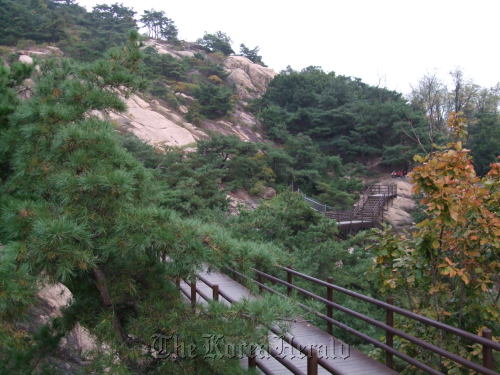Mountains and recreational forests throughout the capital emit levels of antimicrobial compounds as high as levels reported at mountains of Jiri and Seorak, according to a study released Friday.
The study conducted by Seoul Metropolitan Government found that the 11 mountains and recreational parks in Seoul emit, at highest, 890 parts per trillion by volume of phytoncides.
The study conducted by Seoul Metropolitan Government found that the 11 mountains and recreational parks in Seoul emit, at highest, 890 parts per trillion by volume of phytoncides.

Phytoncides are airborne compounds naturally released by trees and vegetation, preventing them from rotting or being eaten by some insects and animals. Research has found that these phytoncides can relieve stress, lower blood pressure and increase immune functions in humans.
The study found an average of 327 pptv of phytoncides on mounts Bukhan, Nam, Acha, Dobong, Gwanak, Inwang, and recreational areas including Seoul Forest, Seoul Grand Park and Yangjae Citizen Park.
The levels of the antimicrobial compounds, including pinene, camphene and limonene were comparable to those of representative national parks like Mount Jiri.
The highest levels in Seoul were found in parts of the pine forest hiking loop of Mount Bukhan during June, with others following close by with 768 pptv of phytoncides at Mount Nam and 640 pptv at Mount Acha.
In order to promote the mountains, the capital plans to place signs throughout the trails informing hikers of levels of phytoncides in the area.
“People can enjoy forest bathing right here in the middle of Seoul that are second to no other famous forest bathing areas in the nation,” said a city official.
By Robert Lee (robert@heraldcorp.com)








![[Graphic News] More Koreans say they plan long-distance trips this year](http://res.heraldm.com/phpwas/restmb_idxmake.php?idx=644&simg=/content/image/2024/04/17/20240417050828_0.gif&u=)
![[KH Explains] Hyundai's full hybrid edge to pay off amid slow transition to pure EVs](http://res.heraldm.com/phpwas/restmb_idxmake.php?idx=644&simg=/content/image/2024/04/18/20240418050645_0.jpg&u=20240419100350)





![[From the Scene] Monks, Buddhists hail return of remains of Buddhas](http://res.heraldm.com/phpwas/restmb_idxmake.php?idx=652&simg=/content/image/2024/04/19/20240419050617_0.jpg&u=20240419175937)

![[KH Explains] Hyundai's full hybrid edge to pay off amid slow transition to pure EVs](http://res.heraldm.com/phpwas/restmb_idxmake.php?idx=652&simg=/content/image/2024/04/18/20240418050645_0.jpg&u=20240419100350)

![[Today’s K-pop] Illit drops debut single remix](http://res.heraldm.com/phpwas/restmb_idxmake.php?idx=642&simg=/content/image/2024/04/19/20240419050612_0.jpg&u=)